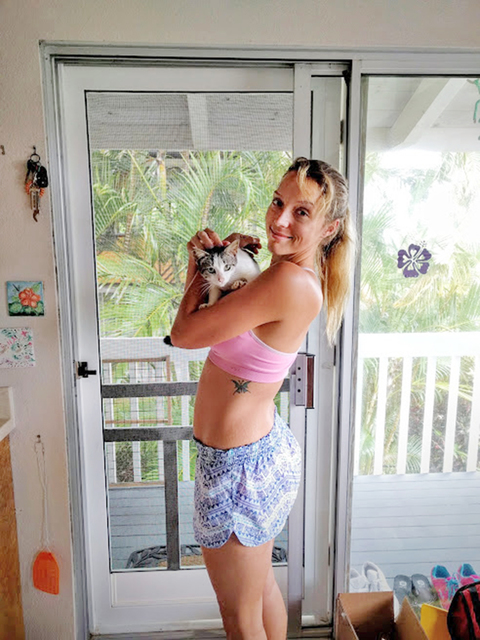She packed up some toys, swallowed tears and carefully placed her 1-year-old cat, Pesh, into a portable carrier.
It was May 6, and Alexis Boyett was headed to the Hawaii Island Humane Society’s Keaau shelter to surrender the cat — originally a stray she found near her Puna home.
Boyett owned Pesh at least six months. In that time, she had the animal sterilized and treated for fleas and played with the frisky young feline daily.
“She was just the sweetest cat,” Boyett said. “From the moment I touched her, I was rehabilitating her. She just took to me loving her.”
The morning of — hours before the surrender — Boyett said she called the Keaau shelter inquiring about adoption and surrender policies. She said she was reassured.
“(A shelter employee said), ‘It will be fine. As long as she’s friendly and she has no diseases, we’ll put her up for adoption,’” Boyett said she was told.
But Pesh was never placed for adoption. Early the next day, Boyett said she called the shelter. She was told her cat was “deemed unfit for adoption” and euthanized the day before — she estimates within five hours after Pesh was dropped off.
Boyett pressed for details but said she was given none. Now, she wants answers.
“(Pesh) wasn’t even given a chance,” Boyett said. “I made it very clear euthanasia was not an option. I told them, ‘If it’s between me coming to get her and you putting her down, I want to get her.’ … They get (money) each year in taxes and they can’t even give my cat 24 hours. How many other animals do they do that to? How many other people do they tell, ‘Oh, it will be fine,’ and they just immediately put it down? If anything, it’s a moral (issue).”
In a statement to the Tribune-Herald, HIHS Executive Director Donna Whitaker said Pesh’s “behavior did not meet socialization standards.”
HIHS evaluates and tests arriving animals “as soon as possible,” Whitaker said in the statement, and feral cats and “cats that are not socialized” are euthanized “as soon as practicable,” contingent on staff availability.
Boyett doesn’t think Pesh was aggressive. If anything, the cat was scared, Boyett said.
Immediately after the incident, Boyett took to social media to spread the word, attracting the eye of the Big Island Dog Rescue, a vocal opponent of HIHS and its euthanasia rates.
The rescue group also is suing the Humane Society, alleging a smear campaign based on what appears to be a series of emails and claiming HIHS stole credit for the air shipment of dogs off-island early last year. HIHS has since filed a counterclaim and says the emails are fabricated.
“I feel like I was lied to, I feel like they tricked me,” Boyett said. “Whether or not I signed a paper (surrendering my rights), this was a living animal that’s obviously loved. If they were willing to help her out, they would have at least called and said, hey, we don’t have room, are you sure you want to drop her off — our euthanasia rate is very high.”
Statistics show HIHS, an open-admission shelter that accepts all animals regardless of breed, age or other factors, euthanized about 80 percent of its 6,568 cats in 2015.
However, at least 75 percent were feral or “unhealthy,” the society reports, and only 413 of those euthanized cats last year — about 6 percent — were actually treatable.
Those statistics aren’t too far out of line with national rates, which show about 70 percent of cats in shelters throughout the country are put down each year. In Hawaii, up to 30,000 cats are euthanized every year, said Inga Gibson, Hawaii state director of the Humane Society of the United States — which is not affiliated with HIHS. Up to 70 percent of those are put down for behavioral issues.
And Boyett relinquished her legal rights to Pesh when she surrendered her, Gibson said.
“It’s standard practice. When someone surrenders, they won’t be contacted,” she said. “That’s why (surrendering) is a pretty serious decision.”
But cats should be held — at minimum — 24 hours after a surrender, Gibson said. That’s “recommended practice” even though state law doesn’t mandate a minimum holding period, nor does the HIHS’s $1.982 million annual contract with the county for animal control services specify a holding period.
“It’s very common for the friendliest, most socialized loving cat in a new environment such as a shelter — where there are lots of smells and animals — (to) display the behavior to that of a feral or unsocialized cat,” Gibson said. “No euthanasia decision should be made based on temperament within the first 24 hours. Most shelters allow the animals a cooling-off period. That’s good practice.”
The issue boils down to trust — community members should “want to take animals (to shelters) rather than abandoning them or leaving them to suffer in the streets,” Gibson said. She thinks Boyett’s incident could be a learning opportunity and a chance to make changes.
“We need public trust and confidence in the local shelters,” Gibson said. “So we encourage shelters to always be evaluating and reevaluating their policy or protocols. Regardless of the details, should something have been done different to prevent this? What was the miscommunication? … You don’t want something like this to happen.”
Email Kirsten Johnson at kjohnson@hawaiitribune-herald.com.



